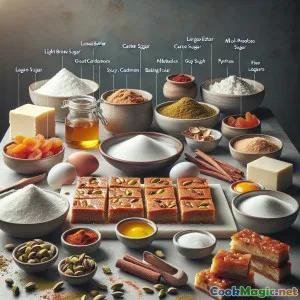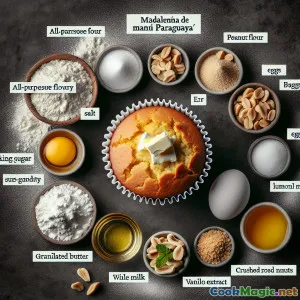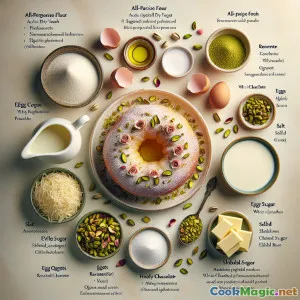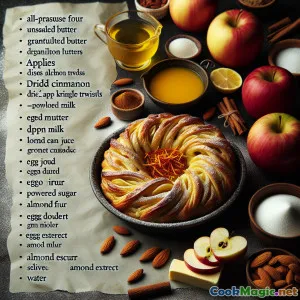
香料豆蔻与哈里萨甜点棒的配方
(Spiced Cardamom & Harissa Dessert Bars Recipe)
(0 评论)食材
-
150 grams 无盐黄油
(Softened to room temperature)
-
150 grams 浅棕色糖
(包装)
-
50 grams 细砂糖
-
2 pieces 大鸡蛋
(室温)
-
2 teaspoons 香草提取物
-
2 teaspoons 咖喱粉
(建议使用现磨)
-
1.5 tablespoons 哈里萨酱
(根据口味调整)
-
210 grams 通用面粉
(过筛)
-
1 tablespoon 玉米淀粉
-
1 teaspoon 泡打粉
-
0.5 teaspoon 细海盐
-
40 grams 开心果
(Coarsely chopped, plus extra for garnish)
-
40 grams 干杏
(切丁)
-
60 grams 希腊酸奶
(Adds moisture)
-
70 grams 糖粉
(For icing drizzle)
-
2 teaspoons 柠檬汁
(For icing drizzle)
(Softened to room temperature)
(包装)
(室温)
(建议使用现磨)
(根据口味调整)
(过筛)
(Coarsely chopped, plus extra for garnish)
(切丁)
(Adds moisture)
(For icing drizzle)
(For icing drizzle)
营养
- 份量: 12
- 每份大小: 1 bar (approx 60g)
- Calories: 261 kcal
- Carbohydrates: 34 g
- Protein: 4 g
- Fat: 12 g
- Fiber: 2 g
- Sugar: 17 g
- Sodium: 120 mg
- Cholesterol: 43 mg
- Calcium: 36 mg
- Iron: 0.9 mg
制作步骤
-
1 - Prep Baking Pan:
Preheat your oven to 180°C (350°F). Line a 20x20 cm baking pan with parchment paper, leaving overhang on two sides for easy removal.
-
2 - Cream Butter & Sugars:
In a large bowl, beat together softened butter, brown sugar, and caster sugar until light and fluffy. Use a hand mixer for best results.
-
3 - Add Wet Ingredients:
Mix in eggs one at a time, then beat in vanilla extract and Greek yogurt until smooth.
-
4 - Spice & Harissa:
Stir in ground cardamom and harissa paste until evenly distributed.
-
5 - Combine Dry Ingredients:
In a separate bowl, combine flour, cornstarch, baking powder, and salt. Gradually fold dry ingredients into wet mixture until just combined.
-
6 - Incorporate Mix-Ins:
Gently fold in chopped pistachios and diced dried apricots, ensuring an even distribution throughout the batter.
-
7 - Transfer & Bake:
Pour the batter into the prepared pan, smoothing the surface. Bake for 30–35 minutes or until a toothpick comes out mostly clean with a few crumbs.
-
8 - Cool & Garnish:
Cool the bars in the pan for 15 minutes, then lift out using parchment overhang. Cool completely on rack. Garnish with a lemon-powdered sugar drizzle and extra pistachios if desired.
-
9 - Slice & Serve:
Cut into 12 bars. Serve with tea, coffee, or as a standalone rich finish to a meal.
Preheat your oven to 180°C (350°F). Line a 20x20 cm baking pan with parchment paper, leaving overhang on two sides for easy removal.
In a large bowl, beat together softened butter, brown sugar, and caster sugar until light and fluffy. Use a hand mixer for best results.
Mix in eggs one at a time, then beat in vanilla extract and Greek yogurt until smooth.
Stir in ground cardamom and harissa paste until evenly distributed.
In a separate bowl, combine flour, cornstarch, baking powder, and salt. Gradually fold dry ingredients into wet mixture until just combined.
Gently fold in chopped pistachios and diced dried apricots, ensuring an even distribution throughout the batter.
Pour the batter into the prepared pan, smoothing the surface. Bake for 30–35 minutes or until a toothpick comes out mostly clean with a few crumbs.
Cool the bars in the pan for 15 minutes, then lift out using parchment overhang. Cool completely on rack. Garnish with a lemon-powdered sugar drizzle and extra pistachios if desired.
Cut into 12 bars. Serve with tea, coffee, or as a standalone rich finish to a meal.
关于 香料豆蔻与哈里萨甜点棒的配方 :的更多信息
Cardamom Scented Harissa Dessert Bars: A Sweet, Spicy, Aromatic Journey
Introduction & Inspiration
This recipe for Cardamom Scented Harissa Dessert Bars was crafted as an adventurous blend of flavors rarely paired in classic British or European sweets. The idea behind this unique treat comes from the crossroads of Middle Eastern spice-laden desserts and the beloved comfort-food quality of British traybakes. Traditionally, cardamom shines in chai or kheer; harissa, meanwhile, is famed for its vibrancy in savory Tunisian and North African cuisine. With fusion cuisine blossoming in the UK, this dessert represents a fresh, bold palate—juxtaposing sweetness with heady spice and subtle heat, all cradled in a buttery bar.
Historical and Cultural Context
Bar-based treats (traybakes) hold a special fondness in English and British baking, from buttery shortbread squares to intricate oat-flapjack bars. Afternoon tea, an indelible British tradition, has long encouraged playful innovation—offering the chance to experiment with global influences alongside classic scones and Victoria sponge. Cardamom is an ancient spice, long traded throughout the British Empire and widely popular in Middle Eastern, North African, and South Asian cuisines. Its pairing here with harissa—originating from Tunisia but popular around the world—bridges traditions and tells the story of food as a connection between cultures.
Why This Recipe Is Unique
While sweet bars are often enhanced by cinnamon, ginger, or cloves, employing cardamom as a lead note brings a bright citrus-forward aroma that transforms the base of these dessert bars. Harissa, typically reserved for body-warming stews or rubs, acts here as the wild card—lending gentle warmth and a tapestry of roasted chiles, cumin, and coriander. The result is a distinct flavor harmony: spicy, floral, nutty, sweet, and tart, enhanced with chewy dried apricots and the emerald crunch of pistachios.
Recipe Notes & Tips
- Adjusting the Harissa
Not all harissa pastes are created equal; some are robust and fiery, while others are mellower. Taste yours first, and adjust the quantity to achieve your perfect buzz of warmth. For milder palates, starting with just one tablespoon is suggested.
- The Sweet Touch
Apart from balancing the vibrancy of harissa, brown sugar deepens the molasses notes, while caster sugar ensures a finely textured crumb. A touch of Greek yogurt keeps the bars moist and slightly tangy, reminiscent of Middle Eastern yogurt cakes.
- Ingredient Swaps
Dried apricots bring brightness and subtle tartness. You can swap these with chopped dates, figs, or even golden raisins if you're keen on customization. If pistachios are out of reach, try using toasted almonds or walnuts.
- Finishing Touches
The lemon-powdered sugar drizzle adds a final spark of zesty brightness and brings the whole bar together visually. Scatter extra chopped pistachios over the top as an elegant nod to Middle Eastern pistachio desserts.
Cultural Significance
These traybake bars are much more than a dessert; they are edible bridges connecting lands and histories. As the UK’s culinary scene surges with influences from immigrants and trade, innovations such as these bars are both homage to traditional flavors and a testament to how at-home bakers can lead trends. Serve these bars at afternoon tea for a twist, at winter gatherings as a warming treat, or at the end of a summery mezze spread.
Personal Thoughts
I love this recipe for how unassuming it appears—square dessert bars with an earth-toned, glazed surface—but how complex and balletic the flavors become upon tasting. Each bite is layered: silkiness from yogurt, richness from butter, punchy surprise from harissa, perfume from cardamom, and the gently yielding chew of dried fruit. They are conversation starters, memory-makers, and the perfect project for bakers eager to experiment with tradition.
Now, more than ever, food evokes shared experience across worlds. Try Cardamom Scented Harissa Dessert Bars as today’s global teatime marvel—daring, delicious, and destined to become your signature treat.
























